Speech Some Echoes of Melville
Thank you for the invitation to deliver this year's Sir Leslie Melville lecture. When Ian Macfarlane delivered the inaugural lecture in this series in 2002, he said: ‘any objective assessment of achievements would place Sir Leslie among the most distinguished Australians of the past century’.[1] It is a great privilege for me to be able to honour those achievements today.
Leslie Galfreid Melville had a long and close association with the Reserve Bank of Australia. He was a member of the Reserve Bank Board for most of the time between 1960 and 1975. And before joining the Board, he played a critical role in the debates that shaped the mandate given to the Reserve Bank in 1959. It is six decades now since that mandate was passed by Parliament. It has more than stood the test of time. From this perspective alone, we have a lot to thank Leslie Melville for.
In today's lecture I would like to discuss two issues that Melville had strong opinions on.
The first is the appropriate objectives of the central bank.
And the second is his view regarding the impossibility of zero interest rates.
Both of these issues have echoes in today's discussions of monetary policy.
Central Bank Objectives
Over recent decades there has been much discussion in the academic and policy communities as to whether a central bank should have a single mandate – price stability – or a dual mandate – price stability and full employment. In practice, we see examples of both around the world.
Here in Australia though, the Reserve Bank of Australia has neither a single nor a dual mandate – we have a triple mandate. Under the legislation passed in 1959, it is the duty of the Reserve Bank Board to ensure that its policies are directed to the greatest advantage of the people of Australia so as to best contribute to:
- the stability of the currency of Australia;
- the maintenance of full employment in Australia; and
- the economic prosperity and welfare of the people of Australia.
This triple mandate was taken from earlier legislation, passed in 1945, that set the objectives for the central banking division of the Commonwealth Bank. It had its origins in a post-World War II Australia, when ensuring economic stability and high levels of employment were very much top of mind.
Establishing such a broad mandate for the central bank ran against the conventional wisdom of the time, which was that central banking was about just currency and banking. Indeed, in his book on the history of the Reserve Bank, Boris Schedvin was moved to write: ‘This bold declaration of responsibility was a landmark in the history of central banking.’[2]
It was a landmark in the sense that the Australian Parliament recognised that central banking was not only about money and finance, but it was also about jobs and the welfare of our society. As the current governor of the Reserve Bank of Australia, I very much share this perspective. Ultimately, central banking is not only about finance and money; rather, it is about enhancing the economic welfare of the people we serve, primarily through achieving price and financial stability and maximum sustainable employment.[3]
Melville had an important hand in setting this direction. His contribution goes back to at least 1936, when he made a lengthy submission to the Royal Commission on the Monetary and Banking Systems in Australia. The first sentence of that submission reads: ‘The ultimate purpose of monetary policy is to enable the economic system to achieve the optimum use of available resources as far as this is possible’.[4] It was then 23 years later that this idea – in different words – found expression in the Reserve Bank Act 1959.
It is worth recalling that Melville had less success in his quest for full employment to be incorporated into the charters of global economic institutions that were set up after World War II, including the International Monetary Fund. This was not for want of trying – at all the major international economic conferences at the end of the war, he was a strong advocate for what became known as the ‘Full Employment Approach’.[5]
But back to the world of central banking.
Since the early 1990s, the conventional wisdom has been that the best contribution a central bank can make to full employment and economic welfare is to maintain low and stable inflation. This is because by keeping inflation under control and within a narrow range, the central bank can reduce uncertainty and economic distortions and, in so doing, provide a stable foundation for people to make decisions about savings and investment. In turn, this provides the basis for reaching the maximum level of employment that is achievable given the choices that society makes about things such as the social safety net, the nature of employment arrangements, and training and education.
After the high inflation 1970s and 1980s, many central banks adopted an inflation target as the means to deliver the sought-after low and stable inflation. Central banking in many parts of the world became all about inflation control, and adopting an inflation target became the way of delivering that control. As part of this shift, central banks also changed their communication to focus very much on inflation outcomes. Accountability mechanisms were also developed to make sure that the central bank kept its focus squarely on inflation.
This approach made a lot of sense and it worked. Inflation rates have been lower and more stable. Central banks have established strong anti-inflation credentials and expectations of high inflation have been wrung out of the system. Core inflation in the advanced economies has been consistently around 1–2 per cent for the past 20 years (Graph 1). And measures of inflation expectations suggest that inflation is expected to remain low for many years to come.
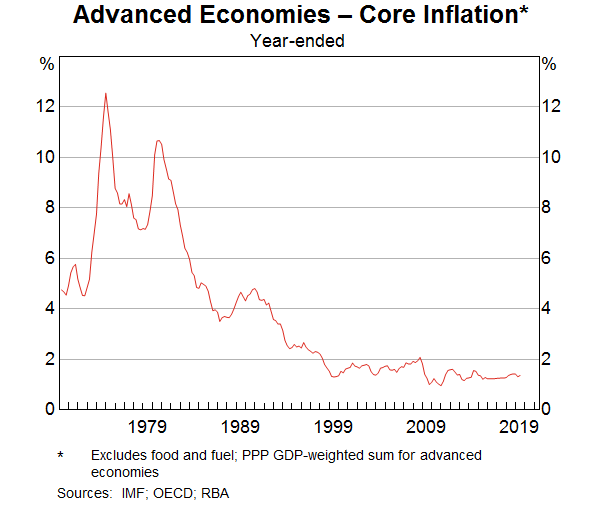
Despite this success, things have not exactly worked out as hoped, and recent experience is causing some rethinking of aspects of the conventional wisdom.
I would draw your attention to two aspects of that experience.
The first is that low and stable inflation is not a sufficient condition for financial stability and thus ultimately full employment. Indeed, it is possible that, in some circumstances, a low and stable inflation environment provides fertile ground for the emergence of some financial stability risks. As we have seen too often, the crystallisation of these risks can have very large welfare consequences, with people losing their jobs, their incomes and their savings. So just achieving low and stable inflation is not enough to maximise economic welfare.
The second aspect that I would like to draw your attention to is that there is more uncertainty than there was previously about what is required to deliver short-run inflation control. This partly reflects some powerful worldwide forces – including technology and increased competition from globalisation – that are affecting inflation dynamics almost everywhere. So it is more difficult to manage inflation tightly than it once was.
In my view, the Australian approach to inflation targeting together with our broad mandate are better suited to this changing world than are more rigid arrangements.
In Australia, since the early 1990s we have had a flexible inflation target. Our target is to achieve an average rate of inflation, over time, of between 2 and 3 per cent. This means that there is an acceptable degree of variation in inflation from year to year, and we have been prepared to use this flexibility. Our focus is very much on the medium term – hence ‘on average’ and ‘over time’. The Board is seeking to provide a strong nominal anchor that people can rely on when making their decisions. Most people in our society can cope with small variations in inflation from year to year, but medium-term uncertainty is much harder to deal with.
Importantly, we have always seen the inflation target as nested within the broader objective of welfare maximisation. This means that the question the Reserve Bank Board asks itself when making interest rate decisions is how those decisions can best contribute to the welfare of the Australian people. In particular, we are seeking to achieve the maximum sustainable rate of employment consistent with inflation being at target. And we are seeking to do this in a way that limits the build-up of financial imbalances that can be the source of instability down the track. In doing this, we can make a material contribution to the welfare of the society we serve.
I acknowledge there is an element of judgement and discretion in this approach. Certainly, there is more judgement involved than in an approach to monetary policy that mechanically sets interest rates so that forecast inflation is at the target in two years' time.
My view is that our more flexible system has served Australia well and can more easily accommodate the changes taking place in the economic system than can other approaches. More generally, I also see longer-term benefits in terms of the standing of central banks in the community if they explain their decisions in terms of jobs and incomes, not just short-run variations in inflation rates. That's not to say inflation control is unimportant – because it clearly is important. Rather, we need to remember that it is a means to an end, and that end is welfare maximisation. I suspect that this is a sentiment that Melville would have agreed with.
I want to emphasise that the discretion we have and our broad mandate to promote the economic welfare of the Australian people do not constitute a licence for the Reserve Bank Board to pursue or advocate economic policies outside our area. Our focus is on inflation control, the labour market, the payments system and financial stability. Dealing with these matters is our contribution to our collective welfare.
I also want to emphasise that the flexibility of our inflation target and our broad mandate – and the discretion it allows – requires a high level of transparency and accountability from us. When we make decisions, there is always an element of judgement and we have to wrestle with difficult trade-offs, where reasonable people can come to different judgements. This means you should expect us to explain our decisions clearly. You should also expect us to explain the various trade-offs we face and how we are balancing them. And as these trade-offs become more complicated in today's world of very low interest rates, you should expect us to be as clear as we can be about how we are viewing these trade-offs and how they are affecting our decisions.
Interest Rates
That brings me to my second topic, and that is the very low interest rates around the world.
Reading through Melville's writings, it is pretty clear that he would have been perplexed about the current state of affairs, in particular the prevalence of zero and negative interest rates.
Writing in the Economic Record in 1938, Melville said ‘Zero interest is a limiting, but unattainable, value analogous to infinity.’[6] He went on to argue that ‘the notion that a zero rate of interest is possible assumes that there is a practicable limit to the amount of useful material which can be profitably employed by society’.
To reinforce this point, he went on to write that at zero interest: ‘Roads would be levelled and straightened regardless of cost. In some places mountains would be dug away and valleys filled to provide residential and agricultural land. Deserts would be watered, beaches would be built in places accessible to cities and provided with artificial sea and sunlight.’
I found it surprising to read this – not just because of the obvious engineering challenges – but because in other writings, Melville was very sceptical about public works and public debt. Understandably, he wanted public money to be spent wisely. So this was quite a contrast. But it reflected his strong view that zero interest rates were an impossibility, because at zero interest rates, people would just borrow, invest and consume and satisfy all their wants.
So as I said, he would be perplexed at the current state of affairs.
As things currently stand, the entire Swiss government nominal bond yield curve is in negative territory (Graph 2). Most of the German, Dutch, French and Japanese yield curves are also in negative territory. The Swiss government, for example, can borrow for 30 years at an interest rate of −0.2 per cent. If it were to issue a zero coupon security at this yield, it would mean that the buyer would give the Swiss government 106 Swiss Francs today and receive back just 100 Swiss Francs in 30 years' time, with no other payments between now and then. That is remarkable. There have certainly been other periods when real bond yields were negative, but such widespread negative nominal yields is unprecedented.
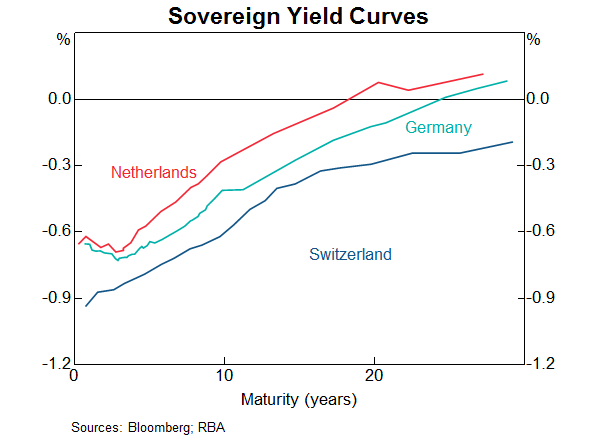
It is not just governments that can borrow at negative yields. Over recent times, private companies including Coca-Cola, Orange and Siemens have issued unsecured bonds with zero coupons and negative yields. It has also become common for European banks to issue covered bonds with negative yields. And in Denmark, at least one bank has offered residential mortgages at a negative rate of interest: −0.5 per cent, although after fees the effective interest rate is just in positive territory.
All up, there are now US$14 trillion of bonds trading at negative yields around the world (Graph 3). And around a quarter of all government bonds globally are now trading at negative yields. Back in 1938, Melville would have struggled to understand this. And, today in 2019, many people also wonder how things could have come to this. In a moment, I will offer some explanations.
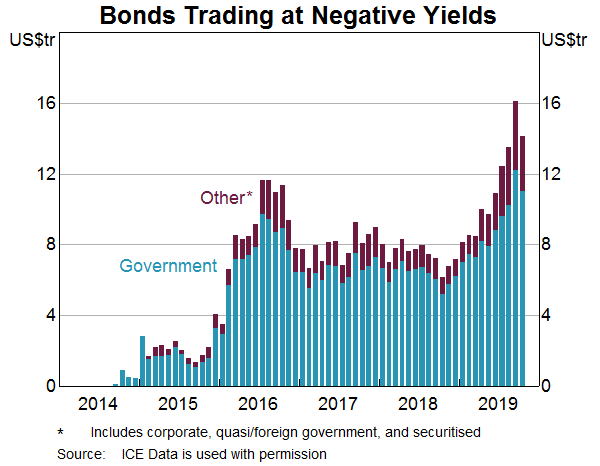
Before I do so, though, it is worth pointing out than even back in 1938, Melville's views about zero interest rates were contested. Following Melville's article, Brian Reddaway and Richard Downing published a conflicting view in the Economic Record with arguments that still have resonance today.[7] They pointed out that even with zero interest rates, there is a limit to borrowing by both individuals and governments. This is because, even if the interest rate is zero, the principal does need to be repaid. And this means that projects undertaken with borrowed money still need to generate a return that is sufficient to repay that principal and also compensate for risk. I suspect that some of Melville's engineering ideas wouldn't have met this test.
So how then do we explain these low interest rates around the world?
Like many questions in economics, a reasonable place to start is supply and demand.
Over recent times, the global supply of savings has been high relative to the demand to use those savings to invest in new productive capital. As a result, the return to savers, especially those who save in low-risk assets, is low.
The question is then: why is the global appetite to save high relative to the appetite to use those savings to invest in new productive capital?
Let me start with savings, and I will focus on three issues. These are: demographic trends; the integration of Asia into the global economy; and the legacy of high levels of borrowing in the past.
First, demographics. Globally, some very large shifts are taking place. In particular, the population in many countries is aging rapidly and life expectancy is continuing to increase (Graph 4). After increasing for many decades, the share of the global population that is aged between 15 and 64 is now declining and this is expected to continue. The United Nations estimates that average life expectancy has increased from just 55 years in 1970 to over 70 years now, and this trend too is expected to continue. While retirement ages have also increased as people live longer, retirement ages have not increased to the same extent as life expectancy, so people are having to plan for more years in retirement, and have been saving more to finance this.
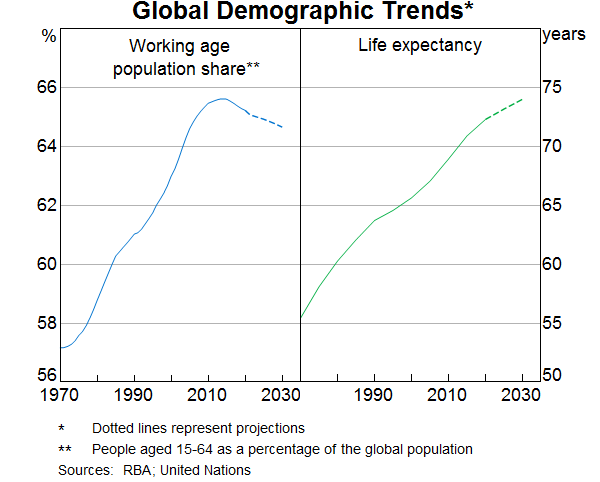
A second important factor influencing global saving outcomes is the rise of Asia. Asian countries now account for around one-third of global GDP, up from just 10 per cent in the early 1980s (Graph 5). People in Asia tend, on average, to save a fairly high share of their incomes. This partly reflects the less extensive social safety nets and the nature of the financial systems. As incomes have risen in Asia, average savings rates in the region have fallen a little in recent years, but they remain higher than in most other parts of the world.
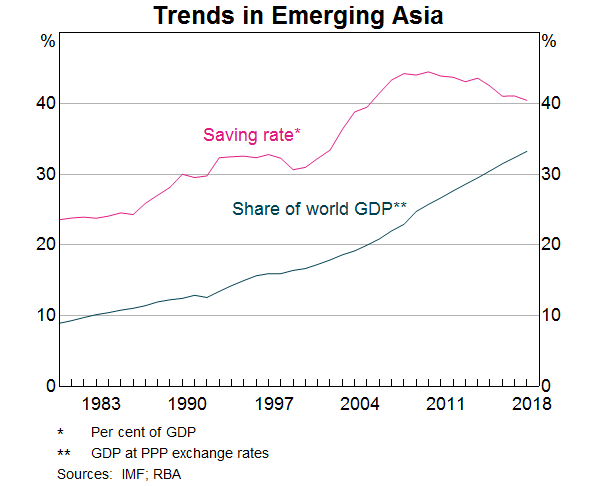
A third factor affecting savings outcomes in many economies is the high level of borrowing in previous years (Graph 6). While the experience differs across countries, at the global level, the stock of debt outstanding relative to GDP has steadily increased for the past 50 years, and is now around a record high. The big shift has been in private debt, particularly in the advanced economies, but public debt has also trended higher over recent decades, after declining following World War II.
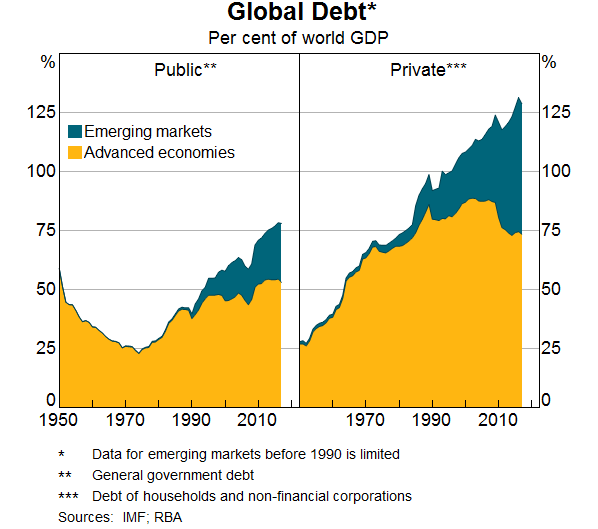
One probable consequence of high levels of debt is that people are more careful with their spending and are less inclined to take on yet more debt. This is especially so when income growth has disappointed, as it has over recent times. In a number of countries, both government and households feel constrained by their previous decisions to borrow and are seeking to put their balance sheets on a sounder footing. One way they can do this is by spending less and saving more.
So these are some of the factors that are influencing global saving outcomes.
I would now like to turn to the investment side of the equation. This is important as you might recall that Melville argued that at zero interest rates there would be an almost unlimited number of things to invest in.
Today's reality, though, is somewhat different. Here again I will point to three inter-related factors. The first is the high level of uncertainty. The second is slower population growth. And the third is some pessimism about future productivity growth.
It is well understood that there has been a high level of global economic policy uncertainty over recent times. This is evident in measures of policy uncertainty calculated from news stories in leading media around the world (Graph 7). The sources of this uncertainty are well known. The long list includes the trade and technology disputes between China and the United States, the Brexit issue, the ongoing tensions in the Middle East, the problems in Hong Kong and the tension between Japan and South Korea. Not surprisingly, these events are making businesses nervous and they are responding by putting off investment decisions. Many would prefer to wait until some of the uncertainties are resolved before proceeding.
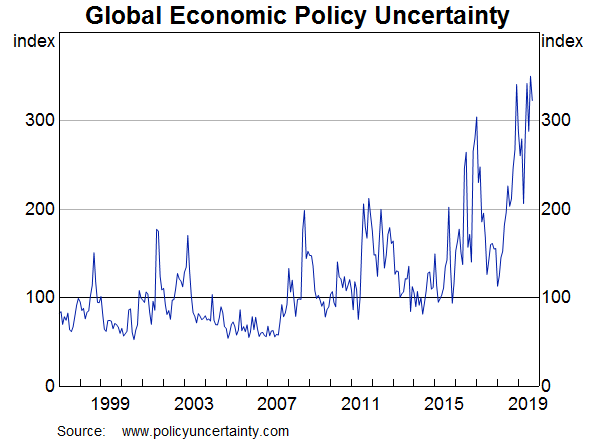
As important as these current geopolitical tensions are, they are not the full story. Businesses face a range of other significant uncertainties, including from the rapid pace of technology change, increased competition as a result of globalisation and ongoing changes to regulatory arrangements. It is probable that the uncertainties generated by these structural changes are interacting and being amplified by the geopolitical issues.
In this context, it is worth noting that despite the marked decline in global interest rates (and some decline in the cost of equity), average hurdle rates of return for new investments in many countries have not changed much (Graph 8). It seems that there is a global norm for hurdle rates somewhere around the 13 to 14 per cent mark and it is hard to shift this norm, even at record low interest rates.
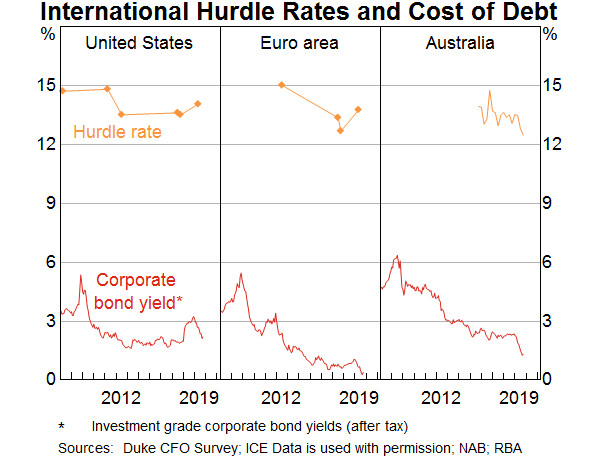
There are a couple of possible explanations for this.
The first is that the reduction in the cost of borrowing has been offset by a rise in the required risk premium due to the uncertainties that I spoke about. If this were so, the hurdle rate would be unchanged, with lower interest rates just compensating for the riskier environment.
The second possibility is that some firms have been slow to adjust to the new reality of low interest rates. We hear reports that a hurdle rate of return of 13 to 14 per cent has been hard-wired into the corporate culture in some companies. Changing this hard-wiring is difficult and time consuming. However, from our liaison with Australian companies, we do know that some companies have lowered their hurdle rates and this is opening up new opportunities for them. It would be good to hear more such reports.
My view is that there is an element of truth to both explanations: risk premiums have gone up and, in some cases, hurdle rates of return are too sticky.
A second explanation for lower levels of investment is a slower rate of population growth, especially in the advanced economies (Graph 9). In the late 1960s, population growth in the advanced economies was running at 1.2 per cent. Since then, population growth has steadily declined, and is now running at just 0.4 per cent. A number of countries in north Asia and in Europe have declining populations and other countries are forecast to join that group before too long.
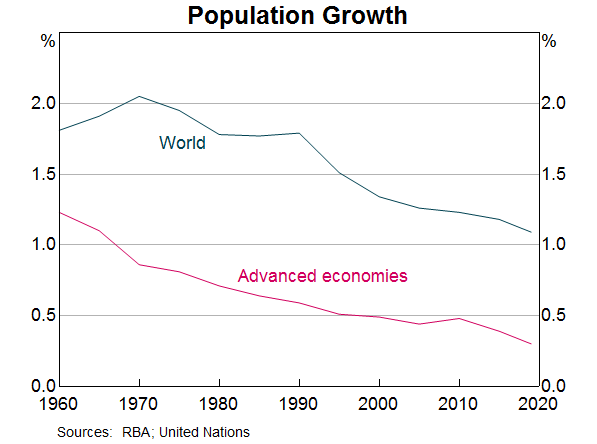
Slower population growth means there is less need to add to the capital stock to accommodate more people. Less home and other building is required, and there is less need to invest in infrastructure to meet the needs of a growing population. While there are some specific areas where more investment might be needed, the overall effect of lower population growth is to reduce investment.
A third explanation for lower investment demand is that people are less optimistic about future economic growth. The slower population growth is part of the story here, but it is not the full story: there is less optimism about future productivity growth as well.
One way of seeing this shift is in estimates of advanced economy potential growth (Graph 10).[8] In the mid 1980s, estimates of potential growth were clustered around 3 per cent. They are now clustered around half of this. Similarly, there has been a downward shift in estimates of potential growth in Asia, especially in China and South Korea. With economies expected to grow less quickly than in the past, there is less incentive to invest.
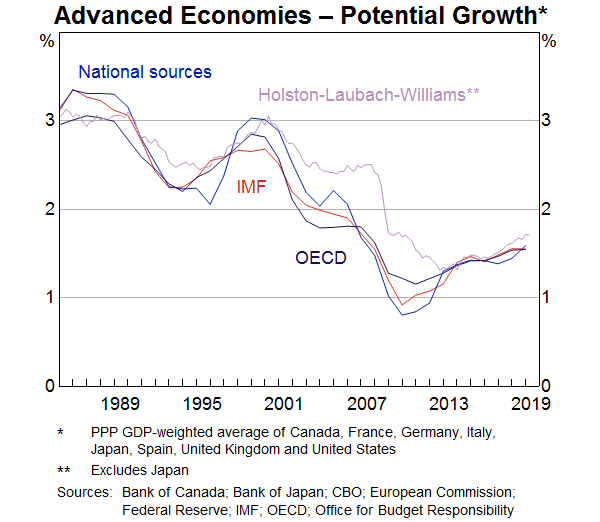
So these are some of the main factors influencing saving and investment globally and that help to explain low global interest rates.
But this is not the full story. Central banks are also playing a role. While our regular explanations for interest rate decisions typically don't reference the broader structural factors that I have just discussed, these structural factors have had a powerful influence on the setting of interest rates over recent times.[9] In addition, central banks have responded to the cyclical position by lowering interest rates and also by buying large quantities of government and long-term securities (Graph 11). Before the financial crisis, the central banks held only around 5 per cent of government securities on issue. Today, they hold nearly 30 per cent. In Japan, the Bank of Japan holds almost 50 per cent of government securities on issue, with these holdings equivalent to 80 per cent of Japanese GDP.
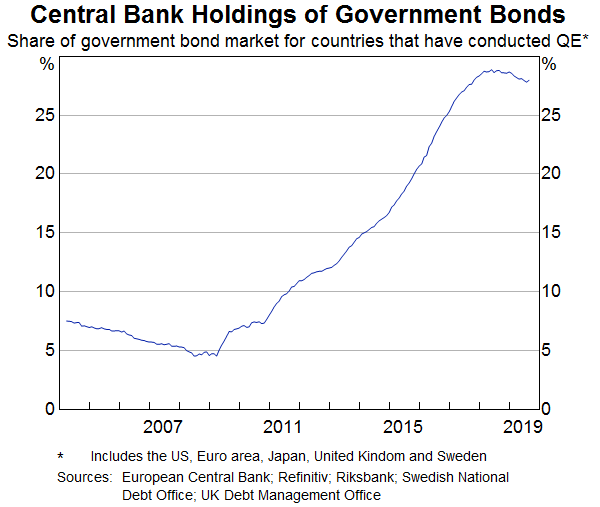
Another significant purchaser of government securities over recent times has been pension funds, particularly in Europe. As prudential regulation has been strengthened, the funds have purchased additional long-dated assets to maturity match their long-dated pension liabilities.
One way of seeing the effect of these various purchases is the term premium (Graph 12). Normally, when an investor purchases a 10-year security, a risk premium is earned over and above the return that is expected from rolling a short-term investment for 10 years. This premium, which historically has averaged around 1½ per cent, is now negative at around minus 1 per cent. This is directly related to purchases of government securities by central banks and others. So this is part of the story too.
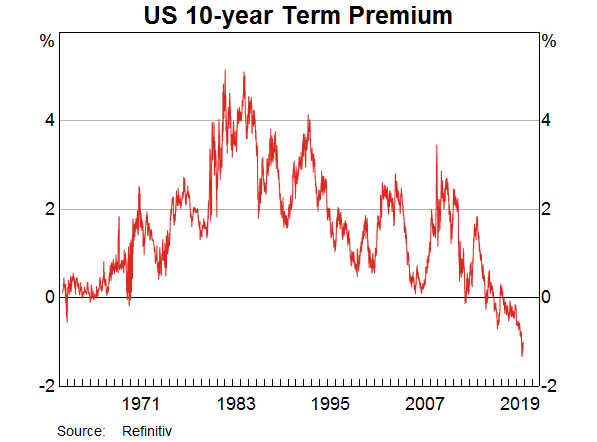
Taking into account all these factors, the key to a return to more normal interest rates globally is to improve the investment climate. While Melville turned out to be wrong about zero interest rates, he was right in another sense. At low interest rates, many investments that didn't make sense at higher interest rates should now make sense. This is especially so for investments with long-term payoffs, because future returns no longer need to be discounted as highly. This means that low interest rates give us the opportunity to lengthen our horizons and think about projects with really long-term payoffs.
There are two central elements in improving the investment climate. The first is the reduction in some of the geopolitical and other concerns that have led to higher risk premiums being required. The second is structural measures that give people greater confidence about future economic growth, so that they are prepared to expand, invest and innovate. Both elements are largely beyond the control of central banks. They are a matter for government and for business.
So this is the environment in which the Reserve Bank Board is setting interest rates. We can't ignore these global trends in savings and investment and the responses of other central banks. If we did seek to ignore these trends, the exchange rate would most likely appreciate. In the current environment, this would be unhelpful for both jobs growth and for achieving the inflation target.
It is important to point out, though, that while we need to take account of these global trends, there is no automatic mechanical link between what is happening elsewhere and our own monetary policy. At each meeting of the Reserve Bank Board we are asking ourselves what is best for the Australian economy and for the welfare of the Australian people.
Over the course of this year we have lowered interest rates three times to a record low of ¾ per cent. We are confident that these reductions are helping the Australian economy and supporting the gentle turning point in economic growth. In doing so, low interest rates are supporting jobs and overall income growth. At the same time, though, we recognise that monetary policy is not working in exactly the same way that it used to. We also recognise that low interest rates hurt the finances of many people, particularly those relying on interest income. So there is a balancing act here.
The Board is prepared to ease monetary policy further if needed. Having said that, it is extraordinarily unlikely that we will see negative interest rates in Australia. It is likely though that we will require an extended period of low interest rates to reach full employment and for inflation to be consistent with the target. As is the case internationally, the focus needs to be on an improvement in the investment environment, so that investors are prepared to take Melville's cue and use low funding costs to build new productive assets. Not only would this help assist with a return to more normal interest rates, but it would be good for our collective welfare too.
Thank you for listening. I look forward to answering your questions.
Endnotes
I would like to thank Ellis Connolly, Selwyn Cornish and Greg Tyler for assistance in the preparation of this talk. [*]
Macfarlane IJ (2002), ‘Sir Leslie Melville: His Contribution to Central Banking in Australia’, Inaugural Sir Leslie Melville Lecture, Canberra, 22 March. [1]
Schedvin CB (1992), In Reserve: Central Banking in Australia, 1945–75, Allen & Unwin, Sydney, p 63. [2]
The Reserve Bank is also responsible for issuing of banknotes, operates the core of Australia's payments system, is the banker to the Australian Government and has regulatory responsibilities in the payments system. [3]
Melville LG (1936), ‘Statement’ in Royal Commission to inquire into the Monetary and Banking Systems at Present in Operation in Australia, Minutes of Evidence, vol. 2, Commonwealth Government Printer, Canberra, p 1117. [4]
Cornish S (2002), ‘Leslie Galfreid Melville 1902–2002’, Economic Record, Vol. 78, No. 243, December, pp 471–478 at 473. [5]
Melville LG (1938), ‘The Theory of Interest–I’, Economic Record, June, pp 1–13. [6]
Reddaway WB and RI Downing (1939), ‘Zero Rates of Interest’, Economic Record, June, pp 94–97. [7]
The estimates for potential growth are from: Holston, Laubach, and Williams (2017), ‘Measuring the Natural Rate of Interest: International Trends and Determinants’, Journal of International Economics, 108, supplement 1 (May), S39–S75, updated at <https://www.newyorkfed.org/research/policy/rstar>; IMF World Economic Outlook; OECD Economic Outlook; and national source estimates by the European Commission, Bank of Canada, Bank of Japan, the US Congressional Budget Office and UK Office of Budget Responsibility. [8]
The paper by Òscar Jordà and Alan Taylor at this year's Jackson Hole Symposium provides one way of decomposing this structural and cyclical response. See Jordà and Taylor (2019), ‘Riders on the Storm’, Federal Reserve Bank of Kansas City Economic Policy Symposium, Jackson Hole, Wyoming, 22-24 August. Available at: <https://www.kansascityfed.org/publications/research/escp/symposiums/escp-2019>. [9]
